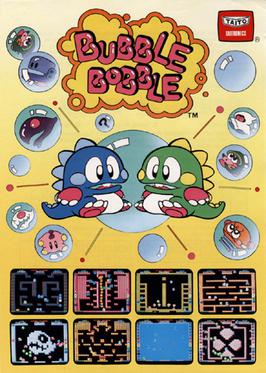
Bubble Bobble is a 1986 platform game developed and published by Taito for arcades. It was distributed in the United States by Romstar, and in Europe by Electrocoin. Players control Bub and Bob, two dragons that set out to save their girlfriends from a world known as the Cave of Monsters. In each level, Bub and Bob must defeat each enemy present by trapping them in bubbles and popping, who turn into bonus items when they hit the ground. There are 100 levels total, each becoming progressively more difficult.
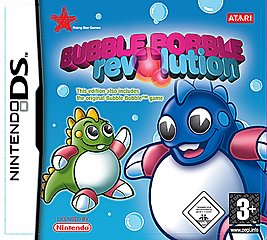
Bubble Bobble Revolution is a 2D platform game for the Nintendo DS. Developed by Dreams, it was released in Japan on 24 November 2005 by Taito as Bubble Bobble DS, in Europe on 2 December by Rising Star Games (distribution handled by and in North America on 3 October 2006 by Codemasters.

Puzzle Bobble 2 is a tile-matching video game by Taito. The first sequel to Puzzle Bobble, it is also known in Europe and North America as Bust-A-Move Again for arcades and Bust-A-Move 2: Arcade Edition for home consoles. Released into the arcades in 1995, home conversions followed for the PlayStation, Sega Saturn, Nintendo 64, and Windows platforms. The game was included in Taito Legends 2, but the US arcade version was included in the US PS2 version instead. Further ports for the Nintendo Switch, PlayStation 4, and Xbox One were released by City Connection alongside Puzzle Bobble 3 in February 2023.
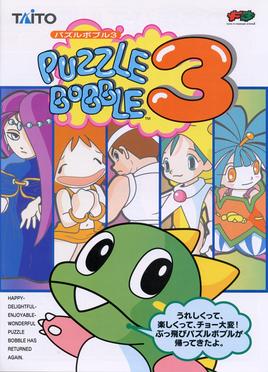
Puzzle Bobble 3 is an action puzzle video game developed by Taito. The second sequel to Puzzle Bobble, it was released for arcades in September 1996 and later ported to the Sega Saturn, PlayStation, Game Boy, Nintendo 64 and Microsoft Windows. Like its predecessors, the player is tasked with shooting balls at groups of balls, creating groups of three or more, which are then removed from play. Further ports for the Nintendo Switch, PlayStation 4 and Xbox One were released in February 2023 by City Connection alongside Puzzle Bobble 2.

Bubble Bobble Part 2, known in Japan as Bubble Bobble 2 (バブルボブル2) is a game in the Bubble Bobble series. While it was never released in the arcade, two versions of the game were developed independently from each other, with each game receiving a different story line as a result. The Game Boy version is known in Japan as Bubble Bobble Junior (バブルボブルジュニア).
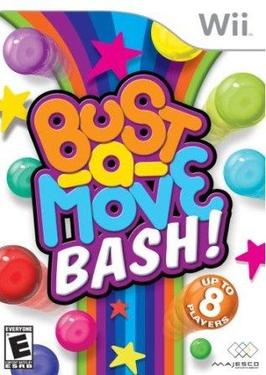
Bust-A-Move Bash!(known in Europe as Bust-A-Move) is a bubble shooter tile-matching video game released exclusively for the Wii, as part of the Bust-A-Move series. It is the first Bust-A-Move game released on a Nintendo console after Bust-A-Move 3000, released in 2003 on the GameCube.

Bubble Bobble Evolution is a game in the Bubble Bobble series for the PSP system.
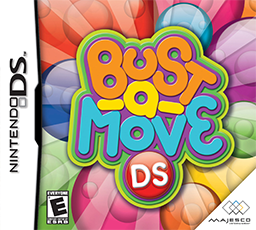
Bust-a-Move DS, known as Pullback!! Puzzle Bobble in Japan, is a puzzle video game developed by Happy Happening and published by Majesco Entertainment for the Nintendo DS handheld video game console.

Rainbow Islands Revolution, known in Japan as New Rainbow Islands, is a platform game for the Nintendo DS. It is an update of the original game, Rainbow Islands. Unlike in the original, the main character, Bub, rides in a bubble, and the player has to guide him with the stylus, and draw rainbows with it as well. The game uses mainly the DS's touch screen.

Rainbow Islands Evolution is a game in the Bubble Bobble series for the PSP system. It is also known as New Rainbow Island: Hurdy Gurdy Daibōken!! in Japan. It is an enhanced remake of the arcade game Rainbow Islands.
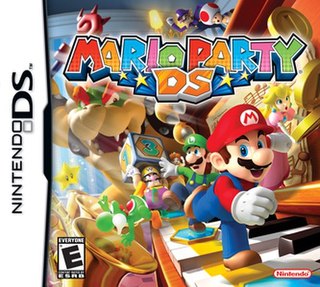
Mario Party DS is a 2007 party video game developed by Hudson Soft and published by Nintendo for the Nintendo DS. It is the second handheld game in the Mario Party series, as well as the last game in the series to be developed by Hudson Soft, as all subsequent titles have been developed by Nintendo Cube. The game was re-released on the Virtual Console for the Wii U in 2016.

MySims Party is a video game developed and published by Electronic Arts as a spinoff to Maxis' The Sims franchise for the Nintendo DS and Wii in 2009. It is the third game in the MySims series. It consists of 50+ mini-games which can be played with up to 4 players. The game was released on March 10, 2009, in North America.

The Sims 2: Apartment Pets is a video game for the Nintendo DS. EA has described as a follow-up to the Nintendo DS version of The Sims 2: Pets. As in the original, it allows a diverse amount of customization, allowing pets to be created in a variety of colors and sizes.

Bubble Bobble Plus! and Bubble Bobble Neo! are remakes of the 1986 arcade game Bubble Bobble. The games were developed and published by Taito. Bubble Bobble Plus! was released for WiiWare in Japan on February 10, 2009, in the PAL regions on April 10, and in North America on May 25, while Bubble Bobble Neo! was released on the Xbox Live Arcade download service for the Xbox 360 in Japan on August 5, 2009 and in North America on September 16 of the same year.
Rainbow Islands: Towering Adventure! is a video game developed by Taito for WiiWare and Xbox Live Arcade. It is the latest installment in the Rainbow Islands series. The game was released in Japan on March 3, 2009, in the PAL regions on May 8, and in North America on June 15. The Xbox Live Arcade version was released on October 28 the same year.

Puzzle Bobble Plus!, known in North America as Bust-A-Move Plus!, and in Japan as Puzzle Bobble Wii, is a video game developed by Taito for WiiWare. It was first released in Japan on April 7, 2009, and later in the PAL regions on June 26, and in North America on July 6.

Space Bust-A-Move is a puzzle video game developed by Lancarse and published by Taito in Japan, and Square Enix worldwide for the Nintendo DS. It was first released in Japan under the title Space Puzzle Bobble on December 18, 2008. It was later released in North America under the title Space Bust-A-Move on July 28, 2009, and in Europe under the title Puzzle Bobble Galaxy on August 28, 2009. As with Arkanoid DS, Space Invaders Extreme and Space Invaders Extreme 2, the game is compatible with Taito's paddle controller.

Bust-a-Move Universe, known in Japan as Tobidasu! Puzzle Bobble 3D, and in the PAL region as Puzzle Bobble Universe, is a puzzle video game developed by Taito and Arika and published by Square Enix for the Nintendo 3DS. It was released in Japan as a launch title on February 26, 2011, and was released in North America on March 27.
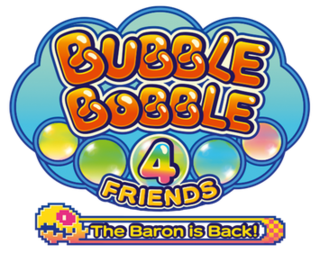
Bubble Bobble 4 Friends is a platform arcade game developed and published by Taito in Japan, and published by ININ games worldwide. The game is part of the Bubble Bobble arcade series. The game's reception had been mixed when it was first released on the Nintendo Switch, but the PlayStation 4 version was better received one year later.
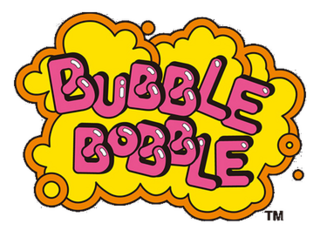
Bubble Bobble is a platform game series originally developed and published by Taito. The first entry in the series, Bubble Bobble, was released in 1986 as an arcade cabinet. In most entries in the series, players control two dragons named Bub and Bob. This was followed by many sequels in both the main Bubble Bobble series, as well as the spin-off Rainbow Islands series. They were published for and ported to a wide variety of arcade and home video game consoles. The most recent release in the series is Bubble Bobble 4 Friends in 2019.



















